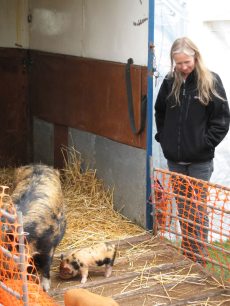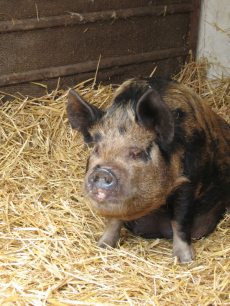We first set eyes on Kune Kune pigs at the Royal Agricultural Show in July 2007, a little over two weeks after my last-ever day at work. Although we had, as yet, no way of achieving our dream of a home in the country, nothing could stop us living the dream in our heads. So we celebrated the fact that we had both taken that final irrevocable step away from the daily drudgery that comes as a free gift with the secure-income-job with a day trip to the second-muddiest show on earth.
Simon lusted after big red shiny tractors and bought an Aussie Bush Hat. I lusted after all things furry and bought a rain coat. It was a showery day, but nothing could dampen our exuberant, dawn-of-a-new-life spirits. There were lots of sheared-and-blow-dried alpacas, looking ridiculous with fluffy fringes and ostrich necks, and a couple of bored llamas doing their utmost to avoid physical approaches from Mr and Mrs General Public and their Grabby Children, within the severe constraints of a two-metre square pen. There were free samples of fancy English cheeses, falconry and ferret-handling displays, and a shudder-inducing tent full of weird and feathersome poultry. There were majestic pigs winning prizes and homely pigs rolling in mud baths. And there was a short, fat, round, hairy ginger and black pig with a squashed nose, snuffling about in a straw-bedded trailer, surrounded by squeally, multi-coloured bundles of snouty joy.
“Hey Val, look at this…” Simon attracted my attention to this new discovery, while trying to capture the memory with his not-long-for-this-world camera.


We read the amateurish leaflet attached to the trailer, flapping limply in the drizzly wind.
A Kune Kune (pronounced Cooney Cooney) is a small New Zealand pig which grows no bigger than a large dog. Their name comes from the Maori word for fat and round. They were much prized by the Maoris for their ability to thrive and fatten on little more than a subsistence diet of grass and kitchen vegetable and fruit scraps. Their gentle nature and lack of interest in escaping or roaming made them popular.
Kune Kune are hairy pigs and come in a range of colours – brown, black, gold, ginger and various spotted combinations. They have distinctive tassels under the chin called ‘piri piri’. They vary between 24” and 30” in height….. Their snouts are medium to short. They have short legs and a round body.
And then the bit that really stuck in our minds…..
They have a fantastic temperament and are very friendly and love to be around people. They are extremely easy to handle, and ideally suit the new pig keeper who may be intimidated by larger more boisterous pigs.
Well that did it. The Large Blacks at Markeaton Park Farm would always have a special place in my heart, but they were exactly what their name said they were. And having watched how they unceremoniously hurled each other out of the way at the food trough, I did indeed find them just a tiny bit (ie: hugely) intimidating.
So the porcine question was settled, and during our traffic-jam conversation on the slow way home, we agreed that – when we somehow managed to do-up and sell our Derby house, and sell our not-country holiday house in France, and find ourselves the perfect little House on the Prairie in the middle of its own fields in dreamland for hardly any euros at all, and had surrounded our happy selves with llamas and chickens and cats and dogs – we would round off the dream picture with a delightful family of friendly little Kune Kunes.






